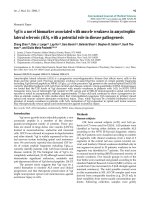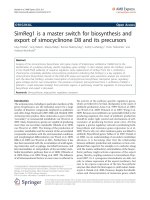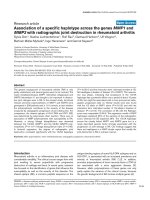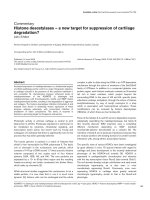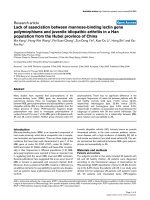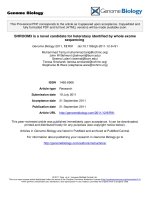Báo cáo y học: "Asthma is a risk factor for acute chest syndrome and cerebral vascular accidents in children with sickle cell disease" ppt
Bạn đang xem bản rút gọn của tài liệu. Xem và tải ngay bản đầy đủ của tài liệu tại đây (220.07 KB, 5 trang )
BioMed Central
Page 1 of 5
(page number not for citation purposes)
Clinical and Molecular Allergy
Open Access
Research
Asthma is a risk factor for acute chest syndrome and cerebral
vascular accidents in children with sickle cell disease
Mark E Nordness
1,2
, John Lynn
3
, Michael C Zacharisen*
4
, Paul J Scott
5
and
Kevin J Kelly
6
Address:
1
Department of Pediatrics, Medical College of Wisconsin, Milwaukee, Wisconsin, USA,
2
Prohealth Care Medical Center, N17 W24100
Riverwood Drive, Suite 150, Waukesha, Wisconsin, 53188, USA,
3
Department of Pediatrics, Medical College of Wisconsin, Milwaukee, Wisconsin,
USA,
4
Department of Pediatrics, Children's Research Institute, Medical College of Wisconsin, Milwaukee, Wisconsin, USA,
5
Department of
Pediatrics, Children's Research Institute, Medical College of Wisconsin, Blood Center of Southeastern Wisconsin, Milwaukee, Wisconsin, USA and
6
Department of Pediatrics, Children's Research Institute, Medical College of Wisconsin, Milwaukee, Wisconsin, USA
Email: Mark E Nordness - ; John Lynn - ; Michael C Zacharisen* - ;
Paul J Scott - ; Kevin J Kelly -
* Corresponding author
Abstract
Background: Asthma and sickle cell disease are common conditions that both may result in
pulmonary complications. We hypothesized that children with sickle cell disease with concomitant
asthma have an increased incidence of vaso-occlusive crises that are complicated by episodes of
acute chest syndrome.
Methods: A 5-year retrospective chart analysis was performed investigating 48 children ages 3–
18 years with asthma and sickle cell disease and 48 children with sickle cell disease alone. Children
were matched for age, gender, and type of sickle cell defect. Hospital admissions were recorded
for acute chest syndrome, cerebral vascular accident, vaso-occlusive pain crises, and blood
transfusions (total, exchange and chronic). Mann-Whitney test and Chi square analysis were used
to assess differences between the groups.
Results: Children with sickle cell disease and asthma had significantly more episodes of acute chest
syndrome (p = 0.03) and cerebral vascular accidents (p = 0.05) compared to children with sickle
cell disease without asthma. As expected, these children received more total blood transfusions (p
= 0.01) and chronic transfusions (p = 0.04). Admissions for vasoocclusive pain crises and exchange
transfusions were not statistically different between cases and controls. SS disease is more severe
than SC disease.
Conclusions: Children with concomitant asthma and sickle cell disease have increased episodes
of acute chest syndrome, cerebral vascular accidents and the need for blood transfusions. Whether
aggressive asthma therapy can reduce these complications in this subset of children is unknown and
requires further studies.
Background
Sickle cell disease is a common debilitating hematologic
disease occurring in 1 in 650 African Americans. Lung dis-
ease is a major cause of cardiopulmonary disability and
Published: 21 January 2005
Clinical and Molecular Allergy 2005, 3:2 doi:10.1186/1476-7961-3-2
Received: 20 July 2004
Accepted: 21 January 2005
This article is available from: />© 2005 Nordness et al; licensee BioMed Central Ltd.
This is an Open Access article distributed under the terms of the Creative Commons Attribution License ( />),
which permits unrestricted use, distribution, and reproduction in any medium, provided the original work is properly cited.
Clinical and Molecular Allergy 2005, 3:2 />Page 2 of 5
(page number not for citation purposes)
mortality [1,2]. Progressive restrictive lung disease related
to recurrent episodes of acute chest syndrome may
develop with advancing age [3]. Acute chest syndrome is
a clinical manifestation triggered by pathological proc-
esses including infections, fat embolism, infarction and
bronchospasm [4]. Nearly 70% of patients with acute
chest syndrome are hypoxemic (as measured by pulse oxi-
metry < 90% or PO
2
< 80 mmHg by blood gas analysis)
[5]. Hypoxemia causes sickle hemoglobin to gel, inducing
red blood cell sickling and vaso-occlusion within pulmo-
nary blood vessels.
Asthma is the most common chronic disease of childhood
occurring in 6% of the general population. Moreover, the
African American population has the highest prevalence
(8%), emergency department (ED) visits, hospitalizations
and risk of mortality of any ethnic population in the
United States [6]. Reversible airway obstruction, airway
inflammation and nonspecific bronchial hyperrespon-
siveness are the hallmarks of asthma. Exacerbations of
asthma result in mucous plugging, bronchoconstriction
with decreased air exchange, ventilation-perfusion mis-
match and subsequently hypoxemia. Aggressive treatment
with oxygen, bronchodilators and oral corticosteroids are
recommended for symptomatic relief of acute episodes.
The African American population is at significant risk for
the occurrence of both diseases simultaneously but little is
known of the affect of asthma on individuals with sickle
cell anemia. In this study, we examined hospitalized chil-
dren with sickle cell disease with concomitant asthma
establishing whether there was an increased rate of acute
chest syndrome or other complications compared to
patients with sickle cell disease without asthma in those
presenting with vaso-occlusive pain crises.
Methods
We performed a 5-year retrospective chart review of 48
children with asthma and sickle cell disease and com-
pared them to a control group of 48 children with sickle
cell disease alone. The 48 children with sickle cell and
asthma represented all patients with complete medical
records with both diseases that were cared for at our
center. These children had no hospitalizations for sickle
cell crises at other facilities. Children in the control group
were matched for age, hemoglobinopathy and gender.
Sickle cell disease was determined by high performance
liquid chromatography and isoelectric focusing analysis
and grouped into phenotypes of hemoglobin SS or hemo-
globin SC.
Children were included in the asthma group if they had
medical record documentation of a discharge diagnosis of
asthma (ICD-493) and had been prescribed asthma
medications.
Vaso-occlusive pain was defined as pain that could not be
explained by injury or infection requiring hospital admis-
sion and treatment with intravenous pain medication.
The criteria for a diagnosis of acute chest syndrome
included respiratory distress, hypoxemia, and a new infil-
trate on chest x-ray that required hospitalization and a
transfusion of packed red blood cells. A cerebral vascular
accident diagnosis was based on the new onset of an acute
neurological syndrome with a focal neurological finding
on examination associated with ischemic changes (images
compatible with stroke) on a brain MRI or computed
tomography scan.
Inpatient admissions were recorded from March 1997 to
March 2002 for episodes of acute chest syndrome, vasooc-
clusive pain crises, cerebral vascular accidents, total blood
transfusions, exchange transfusions and chronic transfu-
sions (monthly blood transfusions).
Exclusion criteria included any child who had incomplete
documentation of their hospital records or those who had
moved into or out of the Milwaukee area during the 5-year
study period. Six children were excluded because they
moved from Milwaukee. The study was approved by the
Investigational Review Board.
Statistical Methods
The Mann-Whitney test was used to evaluate differences
between the incidents of vasoocclusive pain crises, acute
chest syndrome, total blood transfusions and cerebral vas-
cular accidents. Chi-squared analysis was used to evaluate
the number of exchange and chronic transfusions. Statis-
tical significance was given to p values 0.05 or less.
Results
All subjects in the asthma group had asthma recorded in
their medical record with symptoms consistent with
asthma. All had been prescribed albuterol; while 28
(58%) had been prescribed controller medications (24
inhaled corticosteroids, 12 inhaled cromolyn sodium,
and 5 leukotriene modifier). Most patients had been pre-
scribed combination therapy with more than 1 controller
medication or had been switched from 1 controller to
another. There was no reliable means to confirm adher-
ence to the prescribed asthma drug regimen. Seventeen
(35%) subjects had not had prior ED or
hospital admis-
sions for asthma. Of these children, 13 (76%) had been
prescribed only albuterol. Twelve (25%) had at least 1 ED
visit and
at least 1 hospital admission for asthma. Twenty-
six (54%) subjects had only hospital admissions for
asthma, while 15 children had only been treated in the ED
for acute asthma. Of 14 children with a severity category
documented, 9 had mild intermittent asthma, 1 each with
mild persistent and moderate persistent asthma, and 3
with severe persistent asthma. No patient had
Clinical and Molecular Allergy 2005, 3:2 />Page 3 of 5
(page number not for citation purposes)
documented bronchoprovocation with methacholine and
only 3 had documented spirometry with 1 consistent with
airway obstruction, 1 with reversibility of airway obstruc-
tion, and one with poor technique and unreliable results.
Two patients (age 3) were too young for spirometry. Four
subjects had been seen in the Asthma and Allergy clinic
for consultation and the diagnosis of asthma reaffirmed.
Twenty-one (44%) subjects had a primary family member
with asthma. Only 5 children were born preterm (27, 33,
34, 36, and 37 weeks gestation) and none were diagnosed
with bronchopulmonary dysplasia.
The cases and controls were well-matched for age, gender
and type of hemoglobinopathy (Table I). The cases (21
males and 27 females) consisted of 42 children with
HgbSS and 6 with HgbSC. The control group (17 males
and 31 females) included 41 children with HgbSS and 7
with HgbSC. The age of the children ranged from 3 to 18
years old with a mean age of 10.1 years (median 10 years)
for the case patients and 10.3 years (median 10 years) for
the control children.
Patients with sickle cell disease and asthma had signifi-
cantly more episodes of acute chest syndrome, cerebral
vascular accidents, blood transfusions and chronic trans-
fusions as compared to the control group (Table 2).
Admissions for vaso-occlusive pain crisis and exchange
transfusions were not statistically significant between
groups.
No patient with SC disease in either group had a history
of a cerebral vascular accident. Only 1 patient with SC dis-
ease had acute chest syndrome, while 3 children in the
asthma group had acute chest syndrome with one child
experiencing 2 episodes.
Discussion
Despite the high prevalence of these two diseases that
affect the African American population, there is paucity of
research investigating patients with concomitant asthma
and sickle cell disease.
In this study, we discovered that children with both
asthma and sickle cell disease are significantly more likely
to develop severe complications of sickle cell disease
including acute chest syndrome and cerebral vascular acci-
dents compared to children with sickle cell disease alone.
The significance of these findings relates to the hypothesis
that appropriately aggressive treatment of asthma in chil-
dren with sickle cell disease may diminish the frequency
of pulmonary complications.
Patients with reactive airway disease and sickle cell disease
have a lower transcutaneous oxyhemoglobin saturation
[7]. The lower transcutaneous oxyhemoglobin saturation
increases sickling of red blood cells, causing subsequent
gelling and vaso-occlusion in multiple organs leading to
numerous complications. A high prevalence (73%) of air-
way hyperreactivity to cold-air challenge occurs in chil-
dren with sickle cell anemia even in the absence of clinical
symptoms of asthma [8]. Cold air or other provocative
challenge tests had not been performed in our group of
patients. Our results are in agreement with an abstract that
showed 18 children with both asthma and sickle cell dis-
ease had increased hospital admissions for pain crises and
acute chest episodes compared with patients with only
sickle cell disease [9]. Our results are unique because we
assessed for an increased frequency of transfusions and
cerebral vascular accidents in a larger group of patients.
Table 1: Subject Demographics
Patients with
Sickle Cell &
Asthma
Patients with
Sickle Cell
Disease
Males 21 17
Females 27 31
Mean Age 10.1 years 10.3 years
HgbSS 42 41
HgbSC 67
Table 2: Results in children with sickle cell disease with and without asthma
Patients with Sickle Cell
& Asthma (n = 48)
Patients with Sickle Cell
Disease (n = 48)
Statistical Significance
Admissions for Acute Chest Syndrome 90 58 P = 0.03
Number of Cerebral Vascular Accidents 10 2 P = 0.05
Total Blood Transfusions 432 226 P = 0.01
Chronic Blood Transfusions 13 4 P = 0.04
Vaso-occlusive Pain Crises 248 223 P = 0.52
Exchange Blood Transfusions 94P = 0.21
Clinical and Molecular Allergy 2005, 3:2 />Page 4 of 5
(page number not for citation purposes)
Cerebral vascular accidents affect 10% of the children
with sickle cell disease often with devastating long term
implications. The Cooperative Study of Sickle Cell Disease
reported that recent and recurrent episodes of acute chest
syndrome are risk factors for cerebral vascular accidents
[10]. Our findings of increased cerebral vascular accidents
in patients with sickle cell disease and asthma may be due
to their increased and recurrent episodes of acute chest
syndrome. The mechanism linking stroke and acute chest
syndrome is unknown but may be related to hypoxemia
due to pulmonary disease. Hypoxemia has been reported
to increase adhesion of red blood cells to endothelium
[11]. Likewise, increased red blood cell adhesion to pul-
monary endothelium has been associated with bone mar-
row vaso-occlusive crises due to hypoxia, cytokine
expression and fat embolization [12]. Whether hypox-
emia secondary to asthma affects red blood cell and pul-
monary/cerebral endothelium adhesion characteristics is
unknown.
Our study demonstrates that pediatric patients with sickle
cell disease and asthma are more likely to require acute
and chronic blood transfusions. It is not surprising that
these patients needed more frequent transfusions since
treatment for cerebral vascular accidents and severe acute
chest syndrome is blood transfusions. Although SS type of
sickle cell anemia is more severe than SC type, the small
numbers of patients with SC prevent us from making
broad conclusions regarding the degree of risk based on
hemaglobinopathy.
Two studies have demonstrated increased airway hyperre-
activity with reversibility in patients with sickle cell dis-
ease without known asthma [8,13]. Thirty-five percent of
sickle cell patients had evidence of lower airway obstruc-
tion and 78% of these reversed with bronchodilator. Even
in 30% of those with normal lung function, 30% had a
positive response to bronchodilator. Therefore, even
methods to determine the presence bronchial hyperre-
sponsiveness are not sufficient to discriminate asthma
from acute chest syndrome. Whether this hyperreactivity
is due to asthma or is secondary to the pathophysiology of
sickle cell disease is still unclear. Additional studies are
needed to confirm that sickle cell disease is associated
with the development of reversible airway obstruction. If
the association is valid, the effects of routine use of anti-
inflammatory controller agents prophylactically or thera-
peutically would deserve investigation.
A randomized, placebo-controlled trial of 43 episodes of
acute chest syndrome in 38 children revealed that intrave-
nous dexamethasone prevented clinical deterioration in
mild to moderately severe episodes of acute chest syn-
drome [14]. Mild and moderately severe acute chest syn-
drome was defined as respiratory distress, and normal
mental status without pulmonary infiltrates or arterial
hypoxemia. The study excluded children with an exacer-
bation of reactive airways disease. If patients with sickle
cell disease are at increased risk of airway inflammation
and obstruction, successful treatment with intravenous
steroids may have been due to aggressive treatment of
underlying asthma.
Limitations of our study include those inherent in a retro-
spective analysis including selection bias, measurement
bias and confounding factors. The children who received
transfusions for acute chest syndrome likely represent the
more severe form of disease. In contrast, those patients
deemed to have asthma were primarily being treated as if
they had mild to moderate asthma. Only 3 had been diag-
nosed with severe persistent asthma and none were on
daily or every-other-day oral steroids. Importantly, even
individuals with mild intermittent asthma can experience
severe asthma exacerbations. Other sources of potential
error that deserve recognition include the diagnosis of
asthma (whether over-diagnosed or under-diagnosed),
medication compliance and unknown admission to other
hospitals. Although a strict definition of asthma was lack-
ing, the history gleaned from the medical records sup-
ported an asthma diagnosis. Most patients with asthma
are not cared for by asthma specialists and frequently the
diagnosis is made on clinical grounds without formal pul-
monary function testing. Additionally, spirometry was
not routinely performed during ED and hospital admis-
sions. Although other EDs and hospitals in the metropol-
itan area evaluate, treat, and admit pediatric patients with
asthma exacerbations, the concomitant diagnosis of sickle
cell disease likely prompted evaluation at the children's
hospital.
Conclusions
In this small series, children with a history of asthma and
sickle cell disease developed acute chest syndrome and
cerebral vascular accidents more frequently than children
with sickle cell disease without asthma. The implications
of this retrospective study are wide ranging and should
lead to further prospective investigations. Whether aggres-
sive asthma therapy in patients with sickle cell disease and
asthma reduces the incidence of serious complications is
unknown. The potential gains are far reaching and could
make enormous impacts on the morbidity, quality of life
and mortality of many patients.
Competing interests
The author(s) declare that they have no competing
interests.
Authors' contributions
MEN conceived the study, participated in its design and
coordination and drafted the manuscript. JL participated
Publish with BioMed Central and every
scientist can read your work free of charge
"BioMed Central will be the most significant development for
disseminating the results of biomedical research in our lifetime."
Sir Paul Nurse, Cancer Research UK
Your research papers will be:
available free of charge to the entire biomedical community
peer reviewed and published immediately upon acceptance
cited in PubMed and archived on PubMed Central
yours — you keep the copyright
Submit your manuscript here:
/>BioMedcentral
Clinical and Molecular Allergy 2005, 3:2 />Page 5 of 5
(page number not for citation purposes)
in data collection. MCZ participated in coordination and
manuscript preparation. JPS participated in design, coor-
dination and manuscript preparation. KJK participated in
design and coordination.
References
1. Platt OS, Brambilla DJ, Rosse WF, Milner PF, Castro O, Steinberg MH,
Klug PP: Mortality in sickle cell disease: life expectancy and
risk factors for early death. N Engl J Med 1994, 330:1639-44.
2. Powars D, Weidman JA, Odom-Maryon T, Niland JC, Johnson C:
Sickle cell chronic lung disease: prior morbidity and the risk
of pulmonary failure. Medicine 1998, 67:66-76.
3. Nickerson B, Browning I, Vichinsky E, Weiner S: Cooperative
Study of Sickle Cell Disease. Pulmonary function in children
with sickle cell disease. (abstract). Am J Respir Crit Care Med 1994,
149:A374.
4. Vichinsky E, Neumayr L, Earles A, Williams R, Lennette E, Dean D,
Nickerson B, Orringer E, McKie V, Bellevue R, Daeschner C, Manci
E: Causes and Outcomes of the Acute Chest Syndrome in
Sickle Cell Disease. N Engl J Med 2000, 342:1855-1865.
5. Quinn C, Buchanan G: The acute chest syndrome of sickle cell
disease. J Pediatr 1999, 135:416-422.
6. Akinbami L, Schoendorf K: Trends in Childhood Asthma: Prev-
alence, Health Care Utililization, and Mortality. Pediatr 2002,
110:315-322.
7. Leong M, Dampier C, Varlotta L, Stuart M, Allen J: Oxyhemoglobin
desaturation in children with sickle cell disease (abstract).
Am J Respir Critical Care Med 1994, 149:A374.
8. Leong M, Dampier C, Varlotta L, Stuart M, Allen J: Airway hyperre-
activity in children with sickle cell disease. J Pediatr 1997,
131:278-283.
9. Dampier C, Leong M, Allen J: The presence of reactive airway
disease predicts an increased risk for painful episodes in pedi-
atric patients with sickle cell disease (abstract). Pediatric Res
1994, 35:160A.
10. Ohene-Frempong K, Weiner SJ, Sleeper LA, Miller ST, Embury S,
Moohr JW, Wethers DL, Pegelow CH, Gill FM: Cerebrovascular
accidents in sickle cell disease: rates and risk factors. Blood
1998, 91:288-94.
11. Setty BN, Stuart MJ: Vascular cell adhesion molecule-1 is
involved in mediating hypoxia-induced sickle red blood cell
adherence to endothelium: potential role in sickle cell
disease. Blood 1996, 88:2311-20.
12. Gladwin M, Rodgers G: Pathogenesis and treatment of acute
chest syndrome of sickle-cell anaemia. Lancet 2000,
355:1476-1478.
13. Koumbourlis A, Zar H, Hurlet-Jensen A, Goldberg M: Prevalence
and reversibility of lower airway obstruction in children with
sickle cell disease. J Pediatr 2001, 138:188-192.
14. Bernini J, Rogers Z, Sandler E, Reisch J, Quinn C, Buchanan G: Ben-
eficial effect of intravenous dexamethasone in children with
mild to moderately severe acute chest syndrome complicat-
ing sickle cell disease. Blood 1998, 92:3082-3089.

